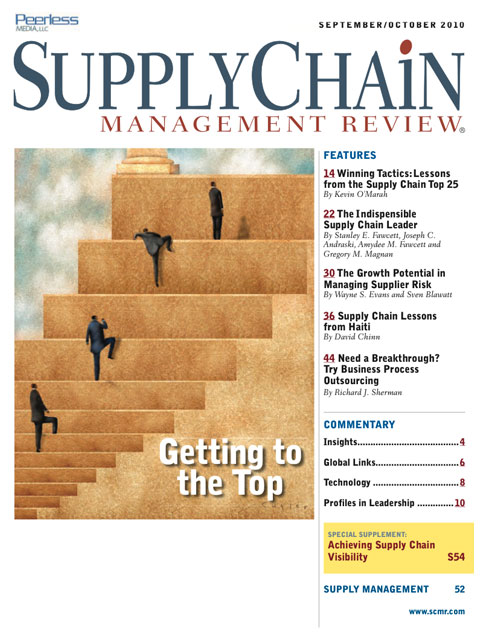Sorry, but your login has failed. Please recheck your login information and resubmit. If your subscription has expired, renew here.
September-October 2010
You’re the Top!” In addition to being a great Cole Porter song, it’s a sentiment all of us would like to hear both in our personal and professional lives. Let’s take the professional perspective here. Looking at things from a supply chain perspective in particular, just how do you get to be considered “the top”? You’re the Top!” In addition to being a great Cole Porter song, it’s a sentiment all of us would like to hear both in our personal and professional lives. Let’s take the professional perspective here. Looking at things from a supply chain perspective in particular, just how do you get to be considered “the top”? Browse this issue archive.Need Help? Contact customer service 847-559-7581 More options
Supply chain managers historically have been under pressure to reduce costs and improve service. But today they are finding it increasingly difficult to effectively respond to this pressure within their operating and capital constraints. The main culprit: an unprecedented level of uncertainty and variability in the supply chain. Volatility in fuel cost, raw material cost, labor cost, and the global economy in general are the new realities.
As supply lines expand and contract with these volatile conditions, simply maintaining—let alone improving—operating performance is a daunting assignment. In today’s “flat world” where new competitors seem to be emerging every day, the challenges of sourcing, manufacturing, and delivering products in global markets has only intensified. And increasingly, this all must be done within the context of sustainability and the economic impact of carbon credits. Implementing an agile and responsive supply network is critical to supply chain performance and risk mitigation today. In fact, this has become essential to any company seeking to improve performance in reliability, cost, and asset management.
That’s the bad news. The worse news is that competition for capital is at an all-time high. And capital for manufacturing assets in particular is often more critical to survival than capital for operating process improvements. For this reason, supply chain managers must look to outsourcing—which has little capital expenditure and usually has a cost advantage—as a means of achieving a more agile and responsive supply network.
 |
This complete article is available to subscribers
only. Click on Log In Now at the top of this article for full access. Or, Start your PLUS+ subscription for instant access. |
Not ready to subscribe, but need this article?
Buy the complete article now. Only $20.00. Instant PDF Download.
Access the complete issue of Supply Chain Management Review magazine featuring
this article including every word, chart and table exactly as it appeared in the magazine.
SC
MR
Sorry, but your login has failed. Please recheck your login information and resubmit. If your subscription has expired, renew here.
September-October 2010
You’re the Top!” In addition to being a great Cole Porter song, it’s a sentiment all of us would like to hear both in our personal and professional lives. Let’s take the professional perspective here. Looking… Browse this issue archive. Download a PDF file of the September-October 2010 issue.
 |
Download Article PDF |
Supply chain managers historically have been under pressure to reduce costs and improve service. But today they are finding it increasingly difficult to effectively respond to this pressure within their operating and capital constraints. The main culprit: an unprecedented level of uncertainty and variability in the supply chain. Volatility in fuel cost, raw material cost, labor cost, and the global economy in general are the new realities.
As supply lines expand and contract with these volatile conditions, simply maintaining—let alone improving—operating performance is a daunting assignment. In today’s “flat world” where new competitors seem to be emerging every day, the challenges of sourcing, manufacturing, and delivering products in global markets has only intensified. And increasingly, this all must be done within the context of sustainability and the economic impact of carbon credits. Implementing an agile and responsive supply network is critical to supply chain performance and risk mitigation today. In fact, this has become essential to any company seeking to improve performance in reliability, cost, and asset management.
That’s the bad news. The worse news is that competition for capital is at an all-time high. And capital for manufacturing assets in particular is often more critical to survival than capital for operating process improvements. For this reason, supply chain managers must look to outsourcing—which has little capital expenditure and usually has a cost advantage—as a means of achieving a more agile and responsive supply network.
 |
SUBSCRIBERS: Click here to download PDF of the full article. |
SC
MR

Latest Supply Chain News
Latest Podcast

 Explore
Explore
Latest Supply Chain News
- 2024 Warehouse/DC Operations Survey: Technology adoption on the rise
- Benchmarking the complexity of ESG reporting
- Looking back at NextGen 2024
- The Corporate Sustainability Due Diligence Directive
- How to make your CFO a supply chain superfan
- AI is moving omnichannel closer to the customer
- More latest news
Latest Resources

Subscribe

Supply Chain Management Review delivers the best industry content.

Editors’ Picks





